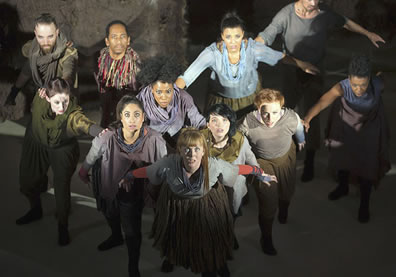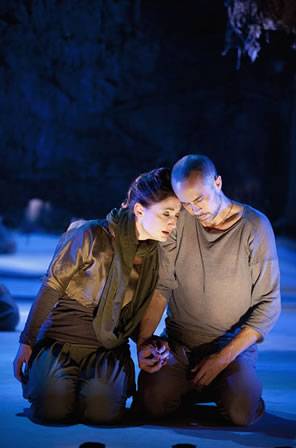The Conference of the Birds
A Life's Migration
By Jean-Claude Carrière and Peter Brook, based on the poem by Farid Uddi Attar
Folger Theatre, Washington, D.C.
Thursday, November 15, 2012, F–8&10 (center right stalls)
Directed by Aaron Posner
 The birds take flight in the Folger Theatre production of The Conference of the Birds, led by the Hoopoe bird, Patty Gallagher. Second row, from left: Annapurna Sriram (Nightingale) and Britt Duff (Sparrow). Third row, from left: Katie deBuys (Duck), Celeste Jones (Dove), Tara Giordano (Partridge), and Jessica Frances Dukes (Peacock). Back row, from left, Jay Dunn (Falcon), Robert Barry Fleming (Parrot), Tiffany Rachelle Stewart (Heron), and Jens Rasmussen (Magpie). Photo by Jeff Malet, the Folger Library. Below, deBuys and Rasmussen experience one of the valleys in silent sorrow. Photo by Scott Suchman, the Folger Library.
The birds take flight in the Folger Theatre production of The Conference of the Birds, led by the Hoopoe bird, Patty Gallagher. Second row, from left: Annapurna Sriram (Nightingale) and Britt Duff (Sparrow). Third row, from left: Katie deBuys (Duck), Celeste Jones (Dove), Tara Giordano (Partridge), and Jessica Frances Dukes (Peacock). Back row, from left, Jay Dunn (Falcon), Robert Barry Fleming (Parrot), Tiffany Rachelle Stewart (Heron), and Jens Rasmussen (Magpie). Photo by Jeff Malet, the Folger Library. Below, deBuys and Rasmussen experience one of the valleys in silent sorrow. Photo by Scott Suchman, the Folger Library.At first you might think you are watching a takeoff on Andrew Lloyd Weber's Cats—only with birds. The falcon proudly erect, arm and leg cocked. The duck vibrating her arms and tail. The partridge parading, the sparrow quivering, the peacock preening, and all the actors performing with jerky head movements, ever-alert postures, and quizzical eyes.
But whereas Cats incorporated T. S. Eliot's poetry into a musical portraying cats as cats with a bit of pop mysticism thrown in, The Conference of the Birds translates a 12th century Sufi poem by Farid Uddi Attar into a stage play using birds as parables of people seeking a supreme power and finding their own inner selves along the way. The mysticism is already there, and it runs so deep you find yourself less remarking on the actors-as-birds than on their avian eyes staring into your own conscious as they share with you their journey—as birds in a story and actors in a play—to seek the great Simorgh.
"Living in the question takes you further than knowing the answers." This profound point was actually made by one of the actresses, Tiffany Rachelle Stewart, during a post-show talkback, but it perfectly sums up the journey we'd just taken with her and her fellow actor birds. Director Aaron Posner not only gathered a talented troupe ranging in experience from Folger veterans to first-job-post-graduation newcomers, he also impressed upon them the importance of making the birds' journeys to self-realization their own. The only role playing, as it were, is the bird mannerisms (choreographed by Erika Chong Shuch): otherwise, the actors pretty much plays themselves. In fact, well into rehearsal, Posner allowed them to switch birds with other actors if they felt a certain species spoke more to and for their own human personas, and several actors reportedly traded roles. The costumes by Olivera Gajic have nothing feathery about them; they are vaguely Aladdin-like or street urchin Persian, with muted colors and layers of fabric and fringes, scarves and corded necklaces. Meghan Raham's set comprises mostly earth-tone panels with telltale mirrors on the Folger stage columns, while composer Tom Teasley plays his Middle Eastern-tinged reed and percussion soundtrack amid a set of cymbals, drums, and keyboards in the gallery above the stage.
It is at a conference that the birds express their belief that they alone among the earth's creatures have no king. However, the Hoopoe bird (Patty Gallagher) tells them they do have a king, the great Simorgh, and that they should journey to see him in his palace beyond the mountains. Many of the birds need convincing. The falcon (Jay Dunn) likes his status among men; the duck (Katie deBuys) doesn't want to leave the comfort of her lake; the sparrow (Britt Duff) is too scared to venture forth; and the partridge (Tara Giordano) is simply too stubborn to change its habits. In this way we are introduced to the various birds—the peacock (Jessica Frances Dukes), the parrot (Robert Barry Fleming), the dove (Celeste Jones), the magpie (Jens Rasmussen), the nightingale (Annapurna Sriram), and the heron (Stewart). Except for Gallagher as the Hoopoe, all the actors play multiple parts, including other birds (and a bat) during the journey as well as human characters in the parables.
The parables, as told by the Hoopoe, are meant to convince the birds to make the journey. These tales are about as philosophically heavy as a fortune cookie, but without the optimism. The slave loves the king, and when the king learns of her love he offers the slave two choices: exile or to have her head cut off. She chooses exile whereupon he orders her head cut off because she valued her head more than her love for him. The princess smiles at the slave, and he, against the advice of his friends, begins stalking her certain she loves him, only to find out that she initially smiled at him only because she considered him foolish.
Another parable, of the princess who makes love to the slave, goes to a whole new mystical plane. In order to have him, she sneaks a potion in his drink, and so it is in a drugged state that the slave spends the night in her bed. When he awakes, he remembers "the vision" but falls into madness because he can't reconcile his memories with his reality. The birds on their journey later encounter this slave, as he has somehow moved from a character in a parable to a real being; except that because he believes he has already experienced heaven, he is certain he is no longer alive. You, watching this, can choose to dwell on the profundity of that slave's dilemma, or you can continue to sort through this along with all the other various elements of what by this point has become a mystical dream. The 100-minute play had started with some semblance of logic but now progresses in a sequence of interactions where what is real and what is vision, what is life and what is storytelling, what is physical and what is spiritual blend as one stream of consciousness.
 But the stream has a course. On their treacherous journey the birds cross seven valleys, each a different state of being. They finally reach the palace of the Simorgh, but at first they are denied entrance. The Hoopoe, she who had been their leader and displayed utmost faith despite all they had encountered, finally sees their journey as for naught, and now she, with the other birds, falls into despair.
But the stream has a course. On their treacherous journey the birds cross seven valleys, each a different state of being. They finally reach the palace of the Simorgh, but at first they are denied entrance. The Hoopoe, she who had been their leader and displayed utmost faith despite all they had encountered, finally sees their journey as for naught, and now she, with the other birds, falls into despair.
What happens next on stage requires a visual translation of the original Sufi poem. In Attar's version, hundreds of birds start the journey but many falter along the way. In the end, only 30 birds reach the palace of the Simorgh: and in Persian, si means "30" and murgh means "bird." On the stage, the Simorgh's chamberlain returns to grant the birds access to their king, and the panels at the back of the set turn to reveal mirrors. The birds see themselves in glittering glory from the stage lights, and then they turn, step to the front of the stage, and speak the play's coda while staring directly into the eyes of the audience.
Posner is a devotee of Peter Brook, one of England's greatest Shakespearean directors of the last half century, who adapted Attar's poem for the theater. In his program notes, Posner admitted of The Conference of the Birds, "I didn't fully understand it when I first read it, and I still don't…but at the same time, it continues to grow and evolve for me. It has always spoken to me, whatever is going on in my life." The actors admitted the same in their talkback, that each day of rehearsal and, still, in each day of the play's run, they discovered new meanings in the play's parables and philosophical points—sometimes it was a meaning for that particular day with an entirely different meaning emerging the next day.
The audience can bring as much intellectual engagement as it choses. Sit back and blithely watch humans acting as birds in a story that plays as a good, sometimes humorous road trip; or lean forward and snatch at the clues in the parables for hidden meanings or grasp the poignant relevance of the birds' experiences. From one end of that spectrum to the other, what you experience watching the birds on their journey, and then connecting with the actors at the end of their journey, is beyond live theater. It's a community conscious shared individually and as singular as fleeting thoughts.
Eric Minton
November 24, 2012
Comment: e-mail editorial@shakespeareances.com
Start a discussion in the Bardroom



 Find additional Shakespeareances
Find additional Shakespeareances